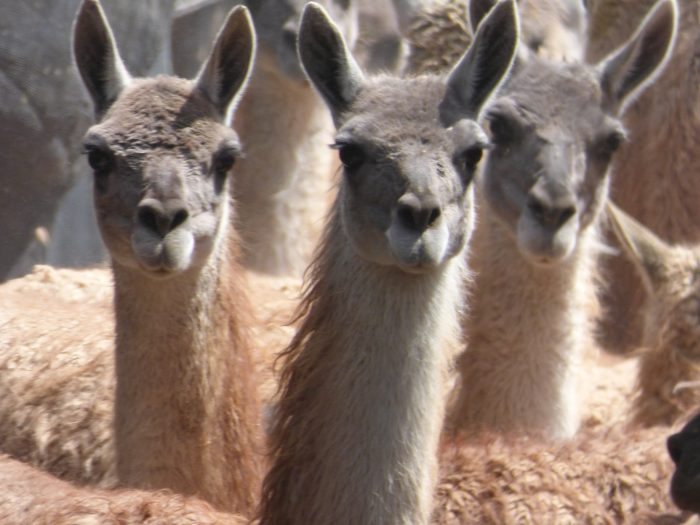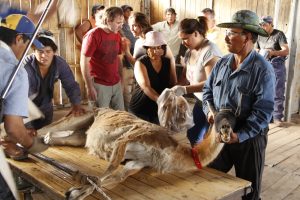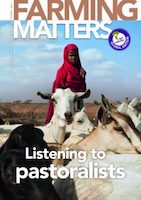As with most wild ungulates, guanacos compete for pasture with domestic livestock. In Southern Patagonia, Argentina, conflict between guanaco conservation and sheep rearing has increased in recent years due to severe droughts and increased desertification. Ranchers hope to declare guanacos as a ‘pest species’ and are starting culling programmes. But a group of pastoralists living in a protected area have taken a different approach, thereby successfully combining live guanaco management with economic empowerment.

La Payunia Provincial Reserve is located in the Malargüe Department, in the south of the Mendoza province in Argentina. The reserve covers approximately 6,540 km2 of state-owned and private lands. It was created in the 1980s in order to preserve the rich flora, fauna, archaeological and scenic beauty of the area. As is the case for other protected areas created in that period, the participation of local people in the design and establishment was very limited. Due to the harsh living conditions, limited amenities and lack of basic services, as well as remoteness from markets and schools, La Payunia is sparsely populated, with only about 150 people living in 42 family groups. These families are widely dispersed and separated from each other. The local economy is based on extensive grazing of goats and sheep to a lesser extent. Limited state and private investment in management has led to low animal productivity, adverse selling conditions, low income, and consequently exacerbating economic marginalisation and environmental degradation.
Conflict resolution

Under these challenging circumstances, in 2005, some inhabitants of La Payunia and surrounds asked the Provincial Department of Renewable Natural Resources for technical advice in order to develop an alternative source of income, and also to reduce conflicts between domestic livestock and guanaco populations. To put some of the advice in to action, they decided to set up the Payun Matru Cooperative. The goal of the cooperative was to implement live shearing of guanacos in order to link conservation with improving their economic situation. The cooperative also aimed to preserve their local culture and encourage young people in particular to remain in the area, rather than leave for nearby cities.
Environmental authorities saw the initiative as a way of creating incentives for local people to accept and help secure the Payunia Protected Area, and to contribute towards guanaco conservation. Thanks to the active work of the cooperative’s president and the technical advisors, the project gained support from several local and international stakeholders, and the cooperative’s social capital increased over the years.
A growing network
The ability of the cooperative to collaborate with multiple partners contributed towards the shearing project’s resilience and created a safety net. As the project developed, collaborations emerged with local and national Departments of Renewable Resources, field biologists and conservation NGOs. This gave the cooperative members more visibility. For example, they participated in conferences and met with government ministers. This increased their negotiating power with potential clients, and they became more empowered – both politically and economically.
The experience merged community development with scientific research and with time, the guanaco captures became ‘open air labs’, where IUCN´s Animal Welfare Protocol for guanaco captures was developed and many young scientists were trained. Cooperative members improved their management and shearing methods and have become experts on guanaco management with high animal welfare standards. Recently, several members were hired by producers from Patagonia to share their expertise on guanaco management.
Towards value adding
The cooperative was always keen to sell processed goods instead of raw guanaco fibre. Given the intensive labour requirements to process the fibre, the next step was to get a semi-industrial mill. In 2012 the Argentinean Ministry of Science and Technology launched a call for proposals targeted at smallholders who could develop camelid fibre value chains. Public-private consortia had to be established in order to apply for this funding so the cooperative formed a consortium with the National Research Council, the National Institute of Industrial Technology and Malargüe Municipality. They were awarded funding to develop the technology needed to support the establishment of a guanaco fibre value chain that would benefit local pastoralists. The project financed some infrastructure for guanaco capture, the installation of a fibre processing plant in a remote village near the protected area, import of specialised machinery from Canada (including the necessary adaptations), capacity building and, the development of guanaco products and by-products.
The guanaco
The guanaco (Lama guanicoe) is the largest native herbivore and main consumer of vegetation in arid and semi-arid environments of South America. Because of this, the guanaco plays a fundamental role in the local ecology. For instance, it is the main prey of the largest native carnivore, the puma. From a historic and cultural perspective, this species has been essential for the survival of local populations for 10,000 years. More recently, they were used by Tehuelches, Onas and Yamanas indigenous groups for clothing, food and shelter. Guanaco fibre is amongst the finest animal fibres, yet value chains are rather under-developed.
Challenges
The processing plant was installed in mid-2015 and since then, cooperative members have learnt how to process guanaco fibre in order to produce different products, such as dehaired fibre, tops and yarns. They also learnt how to process other animal fibres such as vicuña, llama, sheep and cashmere as well as to produce felt. Women tend to work at the mill, whereas most of the guanaco management activities are performed by men. At the moment, all members keep their own economic activities alongside their work with the cooperative because income is still limited.
A challenge, which is shared between the cooperative and other private producers, relates to the lack of an established, transparent market for guanaco fibre and a small overall market demand for the processed products. The similarity between guanaco and vicuña fibre calls for the development of easy methods to help authorities controlling exports and imports to tell them apart.
As in the case of other pastoralists, the Payún Matrú Cooperative faces constraints in realising the economic potential of their system owing to high transaction costs. These include long distances to markets or final consumers, difficulties for marketing and creating distribution channels, limited access to credit facilities and excessive government bureaucracy.
This collective work has inspired individual pastoralists to dream of new projects such as revegetation
Growth and success
Despite these challenges, the cooperative’s membership continues to grow. Many of the new members are young people hoping to make a life in the area, and avoid migration. Training opportunities, the high state investment, technical support and the possibility of generating an alternative source of income are attractive to the youth. In the words of cooperative member Eleuterio: “In the town of Malargüe there are a number of possibilities for getting jobs, whereas here in the protected area we can only work with the goats. Having a mill here, in the middle of nowhere in the desert, can give job opportunities to many people.” But the activities around guanaco management and working at the mill are not only an economic activity, but also a social and cultural event. They provide an opportunity to meet and share experiences with a variety of people and to get organised. This collective work has inspired individual pastoralists to dream of new projects such as revegetation and sheep shearing.
This experience shows that guanacos can be managed collectively and opens new alternatives for guanaco conservation in Argentina and camelid sustainable use in the Andean region. As in the case of vicuña management, the case highlights that the collective management of wild camelids provides more than just economic benefits for local producers. Hopefully the possibility of adding value to wild camelid fibre at the local level will inspire other communities in the Andes to follow this path.
Gabriela Lichtenstein (lichtenstein.g@gmail.com) is coordinator of Proyecto PA.IS, and a researcher of the National Research Council (CONICET) based at the National Institute of Anthropology and Latin American Thought (INAPL) in Argentina.

